5 LinkedIn Systems Generating 8-Figure B2B Pipelines [Complete Teardown]
Discover how systematic B2B companies generate 8-figure pipelines through proven LinkedIn demand engines. Master the POV-to-Pipeline system with documented processes for content creation & engagement.
If you’re not a subscriber, these are the most loved posts:
Distribution Before Product: The Operator's 90-Day GTM Playbook - With Prompts
Free-Tool led Growth - Tactic #2 of 32 - Prompts and Playbooks
Nathan Latka SaaS Playbook - 34 Growth Tactics, 15 Growth Hacks and AI Prompts (Part 1 of 2)
The Lenny Rachitsky Playbook : Prompts, Growth Frameworks, and Strategies - Part 1 of 2
AI (ChatGPT, Gemini, Claude) Prompts for CMOs, Marketers and Growth Builders - Part 1 of 3
While everyone obsesses over "personal branding" and viral posts, a handful of B2B companies have quietly built systematic LinkedIn engines generating an 8-figure pipeline…
What You'll Learn:
This comprehensive playbook reverse-engineers the exact systems used by companies like Storylane, Brij, Gong, and Drift to build predictable demand generation engines on Linkedin.
Inside this guide:
5 Core Growth Loops - The systematic tactics behind 8-figure LinkedIn pipelines
Advanced Measurement Framework - How to prove LinkedIn ROI with full-funnel attribution
90-Day Implementation Playbook - Step-by-step process from POV to revenue
Template Library - Copy-paste content formats and DM sequences that convert
Risk Management - How to scale systematically while maintaining authenticity
Time to read: 10 minutes
Time to implement: 24 Hours to start and 90 days to full systematic operation
Expected outcome: Measurable pipeline generation with documented conversion rates
Storylane publicly credits LinkedIn for driving more than 50% of their sales pipeline through systematic founder-led personal branding and employee advocacy, documented by their VP of Marketing. (Source)
Brij's founder's LinkedIn presence resulted in 10x revenue growth, influenced 50% of deals, and drove a 5x pipeline increase, all through persistent founder storytelling and customer-centric content. (Source)
These aren't founder-led personal brands.
They're systematic, team-operated demand generation machines with documented processes, measurable conversion rates, and predictable pipeline output.
What's different this time:
Not Personal Branding: We're dissecting systematic demand generation engines, not individual thought leadership
Not Growth Hacking: We're revealing documented processes that convert LinkedIn attention into qualified $100K+ deals
Not Vanity Metrics: We're tracking comment-to-revenue attribution with specific conversion rates and pipeline data
The companies winning on LinkedIn have cracked a code:
Point of View → Content Operations → Engagement Systems → Demand Architecture.
This playbook reverse-engineers their exact systems.
Background
B2B LinkedIn represents the largest arbitrage opportunity. Here's why:
Over 1 Billion LinkedIn users, but less than 2% post weekly
54% of B2B decision-makers spend 1+ hour weekly reading LinkedIn thought leadership (as per Edelman-LinkedIn B2B Thought Leadership Impact Report)
LinkedIn content drives 277% more leads than Facebook/Twitter combined (HubSpot B2B Report, 2024)
More than 85% of B2B companies have no systematic LinkedIn demand process
The Opportunity Gap:
Traditional Approach:
Occasional posting by founders
No conversion architecture
Vanity metric focus (likes, shares)
Individual effort, not systematic
Systematic Approach:
Team-operated content engines
Native LinkedIn conversion tools
Revenue attribution tracking
Documented, repeatable processes
Why Now? Because these three macro shifts created this arbitrage:
Algorithm Evolution: LinkedIn prioritized authentic engagement over follower count (2023 update)
B2B Buyer Behavior: 73% research vendors independently before initial contact (Gartner, 2024)
Sales Cycle Compression: Social selling shortens enterprise sales cycles by at least 15%
Market Maturity Levels:
Level 1 (Most Companies): Occasional founder posting, no measurement
Level 2 (Early Adopters): Regular content calendar, basic engagement tracking
Level 3 (Market Leaders): Systematic content operations with conversion architecture
Level 4 (Revenue Machines): Full-funnel attribution from LinkedIn engagement to closed revenue
BTW, If you are in INDIA, we are organizing meetups in Chennai, Hyderabad and Gurugram this September… check out the details on the link.
Core Growth Loops & Systematic Tactics
Loop 1: The POV-to-Pipeline Engine
Case Study: Chris Walker/Refine Labs
The System: Walker's team identified that more than 80% of B2B marketers couldn't prove marketing's revenue impact. They built content around the contrarian POV: "Attribution is fundamentally broken, brand drives demand."
Systematic Execution:
Research Protocol: Weekly analysis of 50+ marketing leader posts to identify conventional wisdom gaps
Content Architecture: 2-3 posts weekly challenging specific attribution myths with data
Engagement System: Comments designed to show prospects struggling with attribution
Conversion Flow: Attribution assessment → diagnostic call → $50K+ retainer proposals
Hidden Tactic: Walker's team created "Attribution Myth Busters" - weekly teardowns of common attribution fails. Each post included a diagnostic question in comments, identifying prospects ready for attribution consulting.
Framework Extraction:
Contrarian POV Development:
Industry Pain Point Research (customer interview data)
Conventional Wisdom Identification (competitor/influencer content audit)
Contrarian Belief Formation (data-backed alternative approach)
Proof Point Development (case studies, metrics, outcomes)
Content Angle Generation (specific posts attacking conventional wisdom)
Loop 2: The Content Operations Machine
Case Study: Katelyn Bourgoin/Why We Buy
The Hidden System: Bourgoin doesn't just post about customer psychology - she's built a systematic content engine that demonstrates psychology principles through her own content strategy.
Content Operating System:
Team Structure:
Insight Miner (2 hrs/week): Monitors customer support tickets, sales calls, user research for content angles
Content Architect (4 hrs/week): Transforms insights into proven psychological frameworks
Engagement Strategist (3 hrs/week): Manages comments/DMs with psychology-based conversation triggers
Conversion Optimizer (2 hrs/week): Tests and optimizes lead magnets based on behavioral triggers
Content Templates (Psychology-Backed):
1. "The Mistake Reveal" - Posts that expose common customer psychology errors
Hook: "I analyzed 847 customer interviews and found this shocking pattern..."
Body: Specific mistake + psychological principle + corrective action
CTA: "What patterns do you see in your customer research?" [surfaces buyer research gaps]
2. "The Before/After Transformation" - Demonstrates psychological principle application
Hook: "This simple psychology principle increased conversions by 23%..."
Body: Before state + psychological insight + after transformation
CTA: "What conversion challenges are you facing?" [qualifies optimization needs]
3. "The Counterintuitive Truth" - Challenges conventional marketing wisdom with psychology
Hook: "Everyone says X, but customer psychology shows Y..."
Body: Common belief + psychological research + contrarian approach
CTA: "Have you tested this with your audience?" [identifies testing opportunities]
Tactic: Bourgoin's "Psychology Case Studies" use her own LinkedIn metrics as proof. Each post about psychological principles includes her specific conversion data, creating compound credibility.
Loop 3: The Engagement Multiplication System
Case Study: Amanda Natividad/SparkToro - Enterprise Pipeline from Systematic Engagement
The Systematic Approach: Natividad identified that most B2B companies engage randomly. She built systematic engagement protocols that compound over time.
Target Account Engagement Protocol:
Week 1-2: Signal Gathering
Monitor target accounts' content consumption patterns
Identify posting frequency, engagement triggers, content preferences
Map decision maker network and influence patterns
Week 3-4: Value-First Engagement
Strategic commenting with specific insights (not generic "great post!")
Share relevant data/resources in comments
Connect dots between their content and customer success stories
Week 5-6: Conversation Escalation
DM with specific value proposition based on observed challenges
Offer exclusive resource/invite based on their content themes
Request brief conversation about shared challenge/opportunity
Comment Ladder Strategy:
Instead of random engagement, systematic progression:
Observation Comment: "This aligns with what we're seeing in [specific industry]..."
Value-Add Comment: "We found [specific tactic] helped with this challenge..."
Data Sharing Comment: "Our recent analysis of [relevant data] supports this..."
Collaboration Hint: "Would love to share our [specific resource] on this topic..."
DM Transition: Direct message referencing specific comment thread
Tactic: Natividad's team created "Engagement Assets" - specific PDFs, datasets, or frameworks mentioned in comments before DM transition. This creates natural conversation bridges.
Loop 4: The Distribution Amplification Engine
Case Study: Gong's Content Multiplication System
The Problem: Most companies treat LinkedIn content as one-and-done. Gong built systematic amplification that extracts maximum value from each piece of content.
The Multiplication Framework:
Single LinkedIn Post Becomes:
Document Post Version: Same content reformatted as native LinkedIn document with embedded CTAs
Carousel Breakdown: Key insights transformed into 5-slide visual story
Video Summary: 90-second video highlighting main points for different learning styles
Newsletter Feature: Expanded version with additional data for email subscribers
Webinar Content: Post insights become talking points for monthly expert sessions
Sales Conversation Starter: Key insights become DM openers for sales team
Partner Co-Creation: Core insight shared with partners for co-created content
Community Syndication: Adapted for relevant Slack/Discord communities
Event Speaking Points: Content insights become conference/podcast talking points
Case Study Foundation: Post data becomes basis for longer-form case studies
Employee Advocacy Multiplication:
Instead of asking employees to "share our content," Gong created systematic advocacy:
The 5-Minute Daily Protocol:
Monday: Share last week's top-performing post with personal insight added
Tuesday: Comment strategically on 3 target account posts with value-add insights
Wednesday: Share relevant industry article with Gong perspective added
Thursday: Engage with partner content, building ecosystem relationships
Friday: Share customer success story or internal insight
Tactic: Gong's "Content DNA Extraction" - they identify the core insight from each post and create 5 different versions optimized for different audience segments and consumption preferences.
Loop 5: The Native Conversion Architecture
Case Study: Drift's LinkedIn-Native Lead Generation
The Insight: Most companies drive LinkedIn traffic to external landing pages, breaking engagement momentum. Drift built conversion architecture using LinkedIn's native tools.
Native LinkedIn Conversion Tools:
1. Document Posts as Lead Magnets:
"The 47-Point Conversational Marketing Audit" (native LinkedIn document)
CTA: "Want the spreadsheet version? Comment 'AUDIT' below"
Follow-up: DM with Google Sheets link + qualification questions
2. LinkedIn Forms for Gated Content:
Embedded forms in sponsored content
Single field: "What's your biggest conversational marketing challenge?"
Automatic LinkedIn data capture + custom qualification
3. Event Creation for Demand Generation:
"Conversational Marketing Breakdown Sessions" (monthly LinkedIn events)
Positioned as peer learning, not vendor presentation
More than 60% attendee rate, and 20%+ convert to sales conversations
4. LinkedIn Polls for Qualification:
"What's blocking your chat implementation?" (poll with 4 options)
Comments reveal specific challenges and buying intent
DM follow-up based on poll response + comment context
The Bridge Asset Strategy:
Problem: Even with native LinkedIn tools, prospects need nurturing before sales conversations.
Solution: Micro-commitments that build toward qualification:
One-Page ROI Calculator: "ConversationalROI.com" (simple, branded microsite)
3-Slide Buyer Guide: "The Conversation Platform Evaluation Guide" (PDF)
90-Second Demo: "See Drift in 90 Seconds" (Loom video)
Assessment Tool: "Conversational Marketing Maturity Assessment" (Typeform)
DM Sequence Architecture:
Traditional Approach: Generic connection request → pitch → rejection
Drift's Systematic Approach:
Sequence A: Document Post Responders
DM 1: "Thanks for your interest in the audit! Here's the spreadsheet version: [link]. Quick question - which section is most relevant to your current situation?"
DM 2: (based on response): "That's exactly what [similar company] was struggling with. We helped them [specific outcome]. Would a 15-minute conversation about their approach be helpful?"
DM 3: (if no response): "No worries if timing isn't right! Here's a quick case study about [their specific challenge] that might be helpful: [link]"
Sequence B: Event Attendees
DM 1: "Great questions during the session! Your comment about [specific challenge] really resonated. We've seen similar issues at [comparable company]."
DM 2: "Would it be helpful to see exactly how [comparable company] solved [their specific challenge]? I could walk you through their approach in a brief call."
DM 3: "I put together a one-page overview of the [comparable company] approach: [link]. Let me know if a quick call would be valuable!"
Tactic: Drift's "Conversation Bridges" - they never ask for meetings directly. Instead, they offer specific value ("see how Company X solved this") that naturally leads to meeting requests.
Which LinkedIn growth loop resonates most with your current B2B strategy? Drop your thoughts
Advanced Measurement Framework
Most companies can't prove LinkedIn ROI because they measure vanity metrics (likes, shares, followers) instead of revenue impact.
The systematic companies built measurement architecture that tracks every step from LinkedIn engagement to closed revenue.
Gong's Full-Funnel Attribution System:
Layer 1: Content Performance Tracking
Post taxonomy: Content type (teach/teardown/narrative) + Topic + CTA type
Engagement quality scoring: ICP account engagement weighted 5x higher than general audience
Comment sentiment analysis: Questions/challenges = buying intent signals
Share velocity tracking: Viral content often indicates market timing
Layer 2: Conversation Attribution
UTM tracking for all LinkedIn→website traffic
"LinkedIn Source" field in CRM for all inbound inquiries
Comment→DM→Meeting tracking through CRM workflow automation
Employee advocacy attribution through team member UTM codes
Layer 3: Pipeline Attribution
LinkedIn-influenced vs LinkedIn-sourced opportunity tracking
Multi-touch attribution: LinkedIn engagement + other touchpoints
Velocity impact: LinkedIn-engaged prospects move 20%-25% faster through sales cycle
Deal size correlation: LinkedIn-originated deals are at least 20% larger
Layer 4: Revenue Attribution
Closed-won revenue with LinkedIn touchpoints in buyer journey
Customer lifetime value correlation with LinkedIn engagement
Expansion revenue from LinkedIn-engaged existing customers
Referral revenue from LinkedIn-connected customers
The Metrics That Matter:
Vanity Metrics (Ignore):
Total followers, likes, shares, post views
Leading Indicators:
ICP account engagement rate
Comment quality score (questions vs. generic responses)
DM response rate from engaged prospects
Meeting acceptance rate from LinkedIn conversations
Lagging Indicators:
LinkedIn-sourced qualified opportunities
LinkedIn-influenced pipeline velocity
LinkedIn-attributed closed revenue
Customer acquisition cost: LinkedIn vs. other channels
Drift's Dashboard Architecture:
Weekly Dashboard:
Content performance by template type
Engagement rates by target account segment
DM response rates by sequence type
Meeting conversion rates from LinkedIn conversations
Monthly Dashboard:
LinkedIn-sourced pipeline vs. goal
Cost per LinkedIn-generated opportunity
LinkedIn vs. paid advertising performance comparison
Employee advocacy program participation and results
Quarterly Dashboard:
LinkedIn-attributed revenue vs. total revenue
Customer lifetime value: LinkedIn-sourced vs. other channels
Sales cycle velocity: LinkedIn-influenced vs. traditional lead gen
Competitive win rate: LinkedIn-engaged prospects vs. cold prospects
Step-by-Step Implementation Playbook
Phase 1: Foundation Architecture (Weeks 1-4)
Week 1-2: POV Development & Validation
POV Research Protocol:
Customer Interview Audit: Analyze last 50 customer conversations for recurring pain points
Competitor Content Analysis: Audit top 20 competitor LinkedIn profiles for conventional wisdom gaps
Contrarian Belief Formation: Identify 3 beliefs that contradict industry conventional wisdom
Proof Point Development: Gather data/case studies that support contrarian beliefs
Content Angle Generation: Create 20 specific post angles that reinforce POV
POV Validation Test:
Post 5 POV-driven pieces of content
Measure engagement quality (comments with questions vs. generic responses)
Track DM responses from target accounts
Identify which POV angles generate most qualified interest
Week 3-4: Team Structure & Role Assignment
For Teams of 2-3:
Content Lead: POV development, strategic content creation, engagement management
Operations Lead: Measurement, process documentation, conversion optimization
Amplification Lead: Employee advocacy, partnership content, distribution
For Teams of 4-7:
Signal Researcher: Market monitoring, competitor analysis, content angle identification
Content Creator: Daily content production using proven templates
Engagement Manager: Comment/DM management, conversation qualification
Conversion Optimizer: Lead magnet optimization, bridge asset creation, attribution tracking
Amplification Coordinator: Employee advocacy, partnership content, multi-channel distribution
For Teams of 8+: Add specialized roles: Video Creator, Data Analyst, Community Manager, Partner Coordinator
Phase 2: Content Operations Launch (Weeks 5-12)
Week 5-6: Content Template Implementation
Template Selection Strategy: Based on successful case studies, implement these proven templates:
1. Monday: The Mistake Reveal (Katelyn Bourgoin format)
Research: Weekend analysis of industry discussions, customer feedback
Structure: "I analyzed [X] and found this shocking pattern..."
CTA: Question that surfaces specific buyer challenges
2. Wednesday: The Data Teardown (Chris Walker format)
Research: Weekly analysis of industry reports, studies, benchmarks
Structure: "Everyone believes X, but the data shows Y..."
CTA: "What data contradicts conventional wisdom in your experience?"
3. Friday: The System Showcase (Internal process transparency)
Research: Document internal processes, results, learnings
Structure: "Here's the exact system we use to achieve [specific outcome]..."
CTA: "What systems are working/not working for your team?"
Content Production Process:
Sunday: Week ahead planning, content angle finalization
Monday: Content creation batch session (3 posts)
Tuesday-Thursday: Daily posting + engagement management
Friday: Week performance review, next week planning
Week 7-8: Engagement System Activation
Target Account Identification:
Tier 1 (Dream Accounts): 25 accounts, C-level engagement required
Tier 2 (Qualified Prospects): 75 accounts, director+ level engagement
Tier 3 (Market Influencers): 100 accounts, industry thought leaders
Daily Engagement Protocol:
10 minutes/day per team member
Monday: Tier 1 account engagement (strategic comments with insights)
Tuesday: Tier 2 account engagement (value-add comments)
Wednesday: Tier 3 account engagement (thought leadership support)
Thursday: Comment thread management (respond to engagement on your content)
Friday: DM follow-up with engaged prospects
Week 9-12: Conversion Architecture Deployment
Native LinkedIn Lead Magnets:
Document Post Lead Magnets:
"The 23-Point [Industry] Assessment" (native LinkedIn document)
CTA: "Want the Excel version with calculators? Comment 'ASSESSMENT' below"
Follow-up: DM with link + qualification questions
LinkedIn Form Lead Magnets:
"What's your biggest [industry challenge]?" (LinkedIn native form)
Automatic data capture + CRM integration
Follow-up sequence based on response
Event-Based Lead Generation:
Monthly "Industry Breakdown Sessions" (LinkedIn events)
Positioned as peer learning, not vendor presentation
Registration = qualified lead with specific interest area
Bridge Asset Creation:
Micro-Assessments: 5-question tools that score and provide recommendations
One-Page Calculators: ROI, savings, or efficiency calculators
Comparison Guides: "How to Choose [Solution Category]" frameworks
90-Second Demos: Specific feature demonstrations solving exact pain points
Phase 3: Optimization & Scale (Weeks 13-24)
Week 13-16: Performance Analysis & Optimization
Content Performance Analysis:
Top-performing templates by engagement quality
Highest-converting CTAs by target audience segment
Optimal posting frequency and timing for your audience
Content topics that generate most qualified conversations
Engagement Optimization:
Comment strategies that generate most DM responses
DM sequences with highest meeting conversion rates
Target account engagement patterns and preferences
Employee advocacy participation and amplification rates
Conversion Rate Optimization:
Lead magnet performance by format and topic
Bridge asset effectiveness in moving prospects toward sales conversations
Meeting conversion rates by LinkedIn source type
Pipeline velocity: LinkedIn vs. traditional lead generation
Week 17-20: Advanced Distribution Implementation
Multi-Channel Content Amplification:
Newsletter integration with LinkedIn content strategy
Webinar content development from top-performing LinkedIn posts
Partner co-creation opportunities based on engagement data
Community syndication strategy for relevant industry groups
Employee Advocacy Scale:
Advanced training for team members on strategic engagement
Content library creation for easy employee sharing
Incentive programs for consistent participation
Measurement and recognition for advocacy impact
Week 21-24: Attribution Mastery & Revenue Correlation
Advanced Attribution Setup:
Multi-touch attribution modeling for LinkedIn touchpoints
Customer journey mapping with LinkedIn influence points
Revenue correlation analysis: LinkedIn engagement vs. deal size
Competitive win rate analysis: LinkedIn-engaged vs. cold prospects
Revenue Optimization:
LinkedIn-sourced customer success story development
Expansion revenue opportunities through LinkedIn engagement
Referral generation through LinkedIn-connected customers
Case study creation from LinkedIn-attributed closed deals
Advanced Risk Management & Governance
The Authenticity Framework
Problem: Systematic approaches risk appearing robotic or inauthentic.
Solution: "Systematic Authenticity" - documented approaches that maintain genuine voice while ensuring consistent execution.
Personal Voice Guidelines:
Voice Architecture: Define 3-5 consistent voice characteristics (data-driven, contrarian, practical, etc.)
Story Bank: Maintain library of personal experiences that reinforce POV
Perspective Consistency: Ensure all content ladders back to core contrarian beliefs
Vulnerability Integration: Share specific failures and learnings to maintain authenticity
Anti-Pod Policies:
LinkedIn's algorithm punishes inauthentic engagement. Systematic companies avoid:
Engagement pods (artificial comment/like coordination)
Comment exchanges unrelated to actual interest
Generic comments that don't add value
Mass connection requests without personalization
Algorithm Independence Strategy:
Build approaches that transcend platform algorithm changes:
Direct Relationship Focus: Prioritize DM conversations over public engagement
Email Capture Priority: Move high-quality LinkedIn connections to owned email lists
Value-First Approach: Provide substantial value regardless of algorithmic reward
Conversation Quality: Focus on meaningful interactions over engagement volume
Compliance & Legal Considerations:
Industry-Specific Regulations:
Financial Services: FINRA regulations on social media marketing
Healthcare: HIPAA considerations in customer story sharing
Legal Services: Bar association rules on client solicitation
Technology: Data privacy regulations in prospect research and engagement
Data Privacy Protocols:
LinkedIn Data Usage: Limits on profile information storage and usage
CRM Integration: Compliance with data protection regulations
International Considerations: GDPR, CCPA, and other regional privacy laws
Consent Management: Clear opt-in processes for ongoing communication
Employee Guidelines:
Personal vs. Company Representation: Clear boundaries for employee advocacy
Disclosure Requirements: Industry-specific requirements for company affiliation disclosure
Content Approval Processes: Legal review requirements for sensitive topics
Crisis Communication: Protocols for handling negative feedback or controversies
Key Takeaways
The 5 Non-Negotiable Foundation Elements:
1. POV Clarity Before Content Volume
Most companies start with "post more" instead of "believe something different"
Systematic approach: Develop contrarian POV → Test through content → Measure qualified engagement
Success metric: 60%+ of comments include questions or challenges (indicating genuine interest)
2. Team Operations Beat Individual Heroics
Founder-only LinkedIn approaches don't scale and create single points of failure
Systematic approach: Define roles → Document processes → Measure team performance
Success metric: 80%+ of LinkedIn-attributed pipeline comes from team efforts, not just founder content
3. Conversion Architecture Over Engagement Theater
Vanity metrics (likes, shares, followers) don't correlate with revenue
Systematic approach: Native LinkedIn tools → Bridge assets → CRM integration → Revenue attribution
Success metric: Track dollar value of pipeline per piece of content, not engagement rates
4. Systematic Engagement Over Random Activity
Most companies engage sporadically without strategic focus on target accounts
Systematic approach: Target account identification → Engagement protocols → Conversation progression
Success metric: 70%+ of strategic DMs receive responses and advance to qualification
5. Full-Funnel Attribution Over Last-Touch Credit
LinkedIn's revenue impact is often undervalued due to poor attribution modeling
Systematic approach: Multi-touch tracking → Influence analysis → Long-term value measurement
Success metric: Prove LinkedIn's role in entire customer lifecycle, not just lead generation
The 90-Day Quick-Start Experiments:
Days 1-30: POV Development & Validation
Week 1: Customer interview audit for pain point identification
Week 2: Competitor content analysis for conventional wisdom gaps
Week 3: Contrarian belief development with proof point research
Week 4: POV validation through 5 test posts measuring engagement quality
Days 31-60: Content Operations & Engagement Systems
Week 5-6: Content template implementation with proven formats
Week 7-8: Target account identification and systematic engagement protocol launch
Week 9-10: Employee advocacy program deployment with tracking systems
Days 61-90: Conversion Architecture & Attribution
Week 11-12: Native LinkedIn lead magnet deployment with conversion tracking
Week 13-14: Bridge asset creation and DM sequence optimization
Week 15-16: Full-funnel attribution setup and baseline measurement
The Questions Every B2B Leader Should Answer:
Strategic Questions:
What contrarian belief could differentiate our content in a crowded market?
How much qualified pipeline could we generate if LinkedIn engagement converted at 2-3x current rates?
What would systematic LinkedIn demand generation be worth vs. our current paid advertising spend?
Operational Questions:
Do we have documented processes for content creation, engagement, and conversion?
Can we prove LinkedIn's revenue impact through our current measurement systems?
What percentage of our GTM team is systematically contributing to LinkedIn demand generation?
Performance Questions:
What's our current comment-to-meeting conversion rate from LinkedIn?
How does the average deal size of LinkedIn-sourced opportunities compare to other channels?
What's the sales cycle velocity difference between LinkedIn-engaged vs. cold prospects?
Resource Library & Implementation Tools
Template Library for Immediate Implementation:
Content Templates (Copy-Paste Ready):
Template 1: The Data Contradiction
Everyone believes [conventional wisdom], but the data tells a different story.
We analyzed [specific dataset] and found:
→ [Surprising finding #1]
→ [Surprising finding #2]
→ [Surprising finding #3]
The real insight: [contrarian conclusion]
Here's what we're doing differently: [specific approach]
What data contradicts conventional wisdom in your experience?
Template 2: The System Reveal
Here's the exact system we use to [achieve specific outcome]:
The problem: [common challenge]
Our approach: [systematic solution]
Step 1: [specific action with metric]
Step 2: [specific action with metric]
Step 3: [specific action with metric]
Result: [specific outcome with data]
What systems are working (or not working) for your team?
Template 3: The Before/After Transformation
This simple change increased [metric] by [percentage]:
BEFORE: [specific problematic situation]
THE INSIGHT: [principle or realization]
AFTER: [specific improved situation]
Why it worked: [explanation of underlying principle]
The key was [specific tactical change].
What [relevant challenge] are you facing right now?
DM Sequence Templates:
Sequence A: Document Post Responders
DM 1: "Thanks for your interest in [resource]! Here's the [enhanced version]: [link]. Quick question - which section is most relevant to your current situation?"
DM 2: "That's exactly what [similar company] was struggling with. We helped them [specific outcome]. Would a 15-minute conversation about their approach be helpful?"
DM 3: "No worries if timing isn't right! Here's a quick case study about [their specific challenge]: [link] Feel free to reach out when you're ready to explore this further."
Measurement Templates:
Content Performance Tracker (Spreadsheet Format):
Columns: Date | Post Type | Content Topic | CTA Type | Likes | Comments | Shares | ICP Comments | Questions in Comments | DMs Received | Meetings Booked | Pipeline Generated | Revenue Attributed
LinkedIn Attribution Dashboard (CRM Integration):
Lead Source: LinkedIn Organic
Lead Source Detail: [Content Type - Topic - CTA]
First Touch: LinkedIn Post Engagement
Influence Points: [All LinkedIn touchpoints in journey]
Conversion Path: [Engagement → DM → Meeting → Opportunity → Closed]
Attribution Value: [Percentage of deal value attributed to LinkedIn]
Resources for Continued Learning:
Advanced LinkedIn Strategy:
"The LinkedIn Engagement Study" - analysis of 100K+ B2B posts for performance patterns - Link
"LinkedIn Algorithm Insights 2024" - platform best practices and algorithm updates (Link)
"B2B Social Selling Benchmark Report" - industry performance standards and comparisons (Link)
Content Operations Excellence:
"Content Operations Playbook" by MKT1 - systematic content creation and distribution (Link)
"The Content Code" by Mark Schaefer - behavioral science in content marketing (Link)
"Everybody Writes" by Ann Handley - systematic approach to business writing (Link)
Attribution and Measurement:
"Marketing Attribution Guide" by Bizible/Marketo - multi-touch attribution modeling (Link)
"The Marketing Accountability Imperative" by SiriusDecisions - ROI measurement frameworks (Link)
"Data-Driven Marketing" by Mark Jeffery - statistical analysis for marketing performance
This systematic approach to B2B LinkedIn demand generation represents the difference between random social media activity and predictable revenue generation.
The companies implementing these systems are building sustainable competitive advantages while their competitors struggle with sporadic content and vanity metrics.
The opportunity window for systematic LinkedIn demand generation remains wide open, but it's closing as more companies discover these approaches.
The question isn't whether to build systematic LinkedIn processes - it's how quickly you can implement them before your competitors do.
Loved this post?
And subscribe to “Prompts Daily Newsletter” as well…
If you’re not a subscriber, here’s what you missed earlier:
Distribution Before Product: The Operator's 90-Day GTM Playbook - With Prompts
Free-Tool led Growth - Tactic #2 of 32 - Prompts and Playbooks
Nathan Latka SaaS Playbook - 34 Growth Tactics, 15 Growth Hacks and AI Prompts (Part 1 of 2)
The Lenny Rachitsky Playbook : Prompts, Growth Frameworks, and Strategies - Part 1 of 2
Founder-led Sales : Strategy and Guide (with AI Prompts) - Part 1 of 3
AI (ChatGPT, Gemini, Claude) Prompts for CMOs, Marketers and Growth Builders - Part 1 of 3
Subscribe to get access to the latest marketing, strategy and go-to-market techniques . Follow me on Linkedin and Twitter.



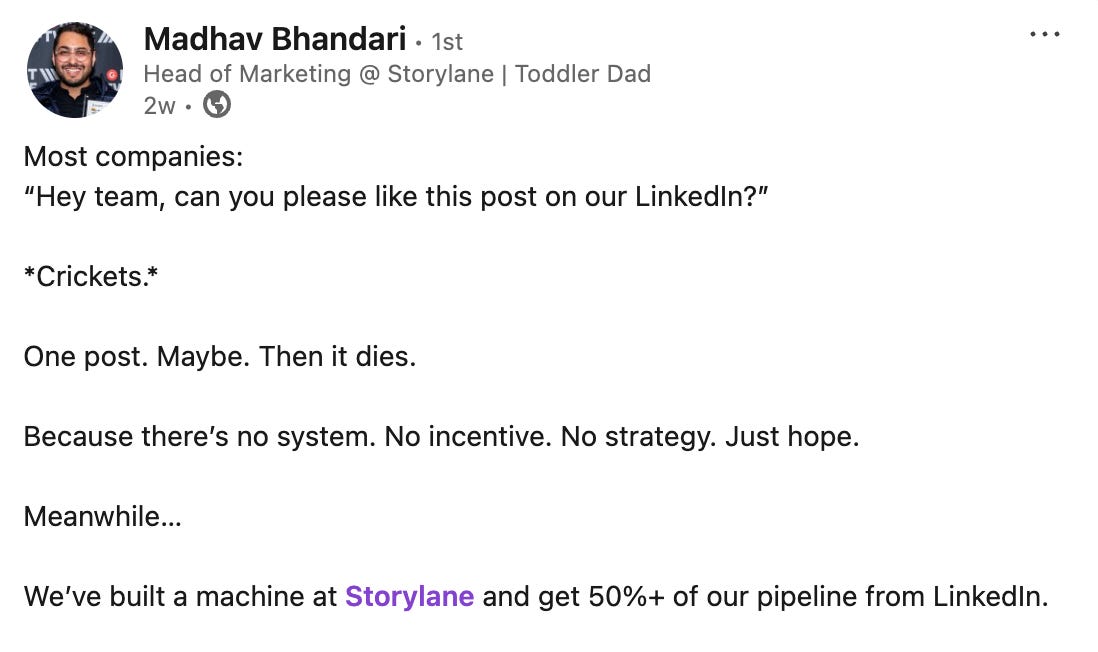
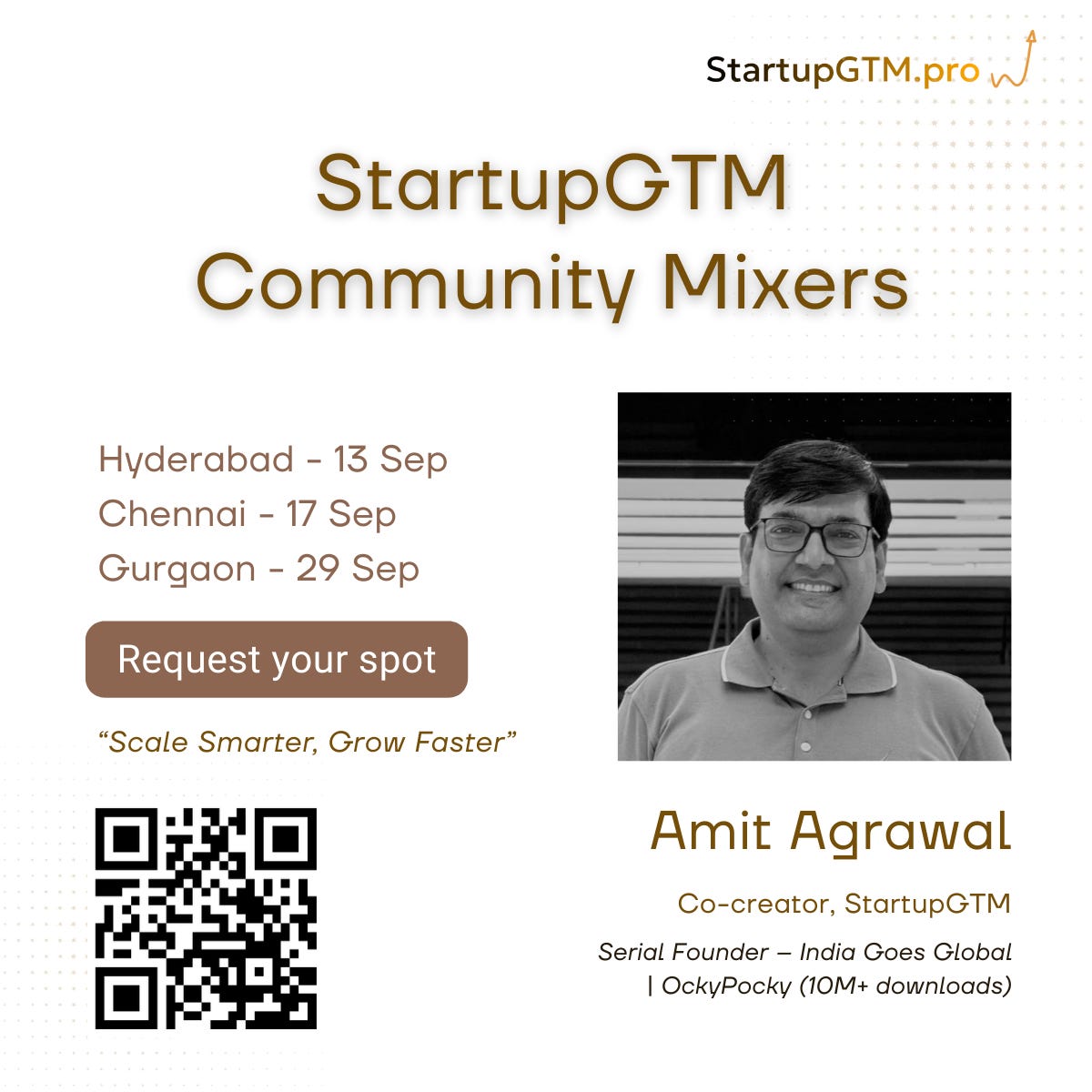
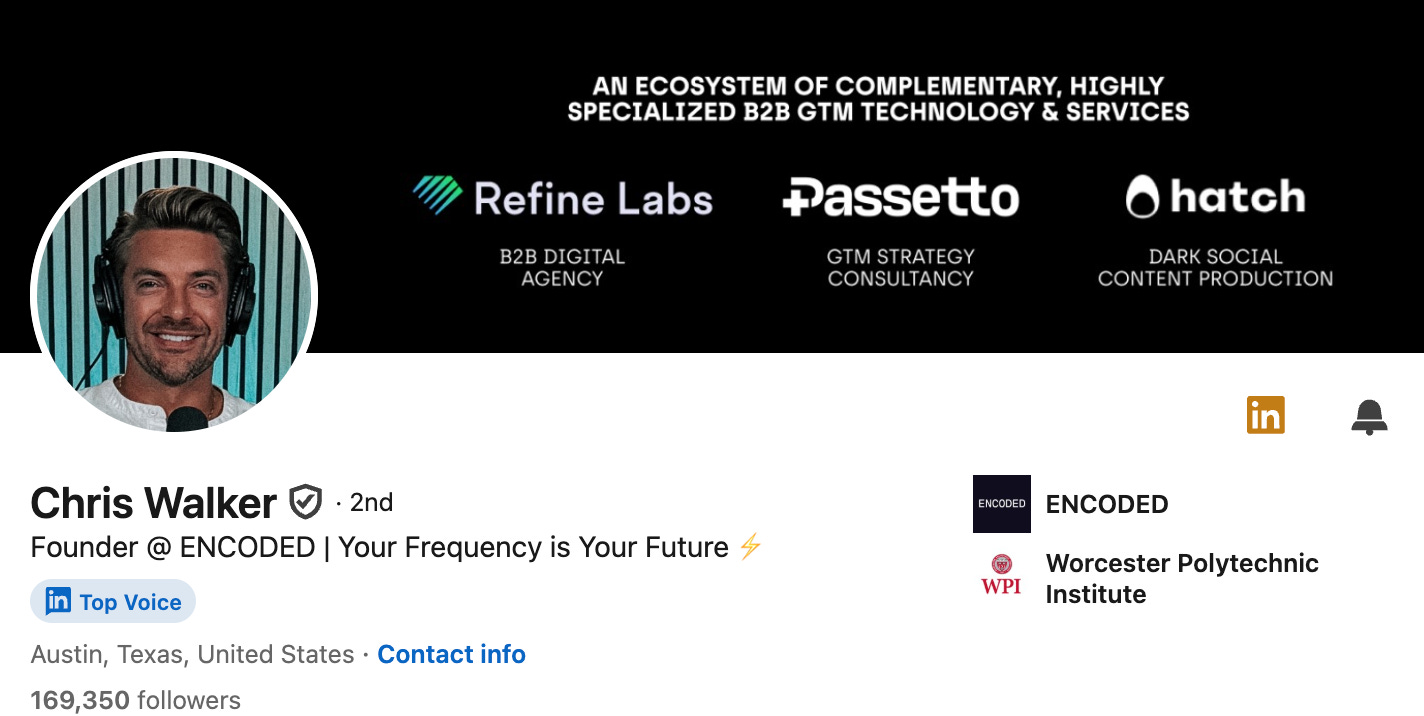
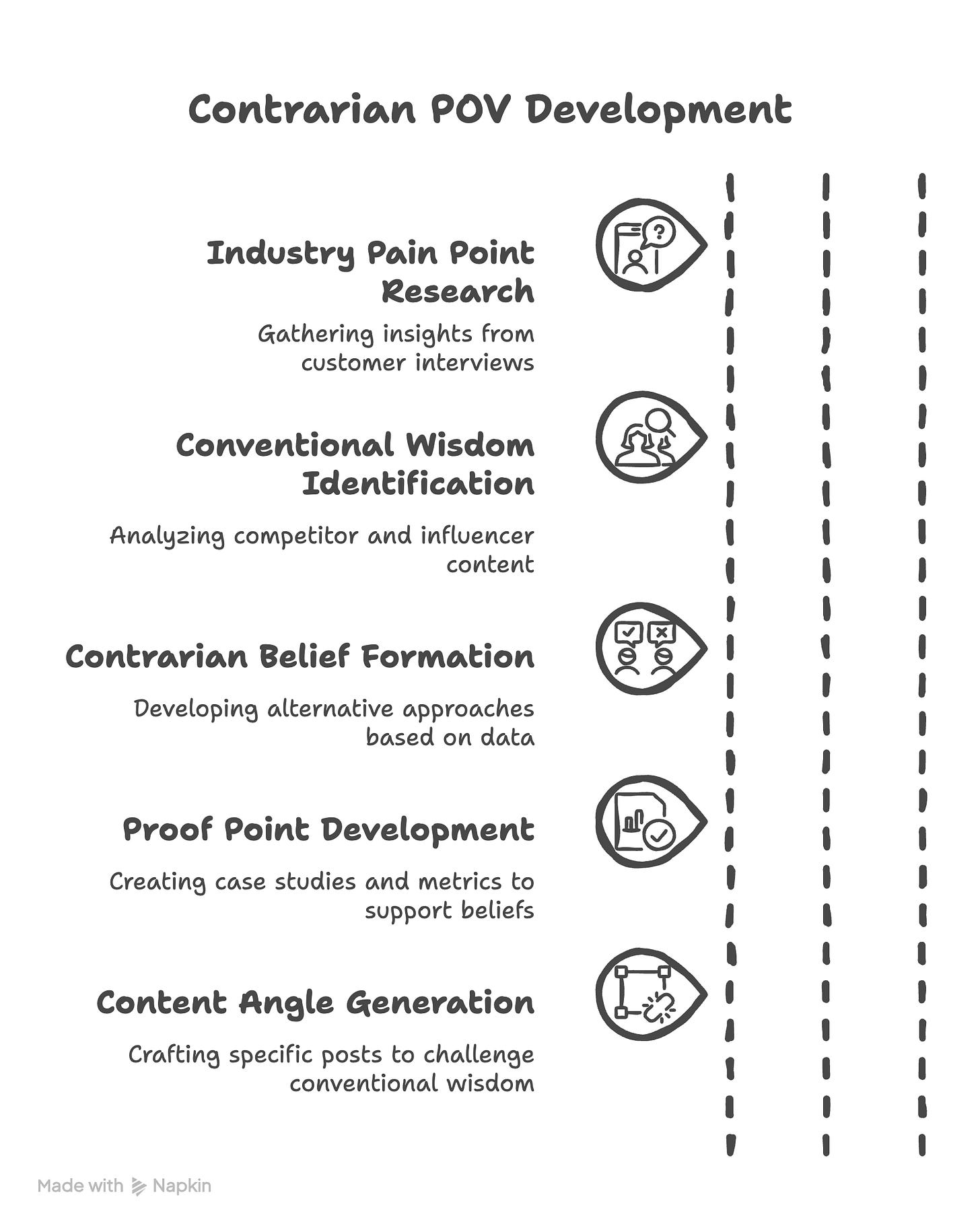

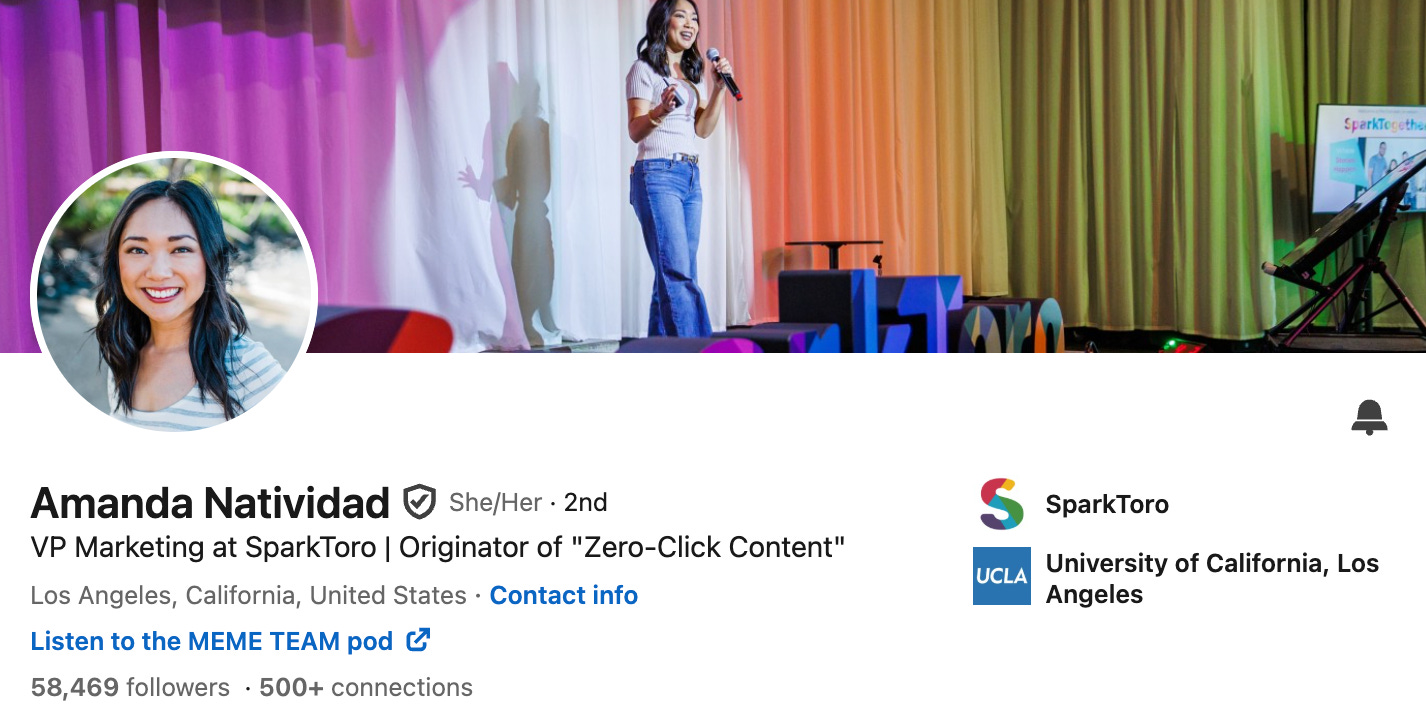
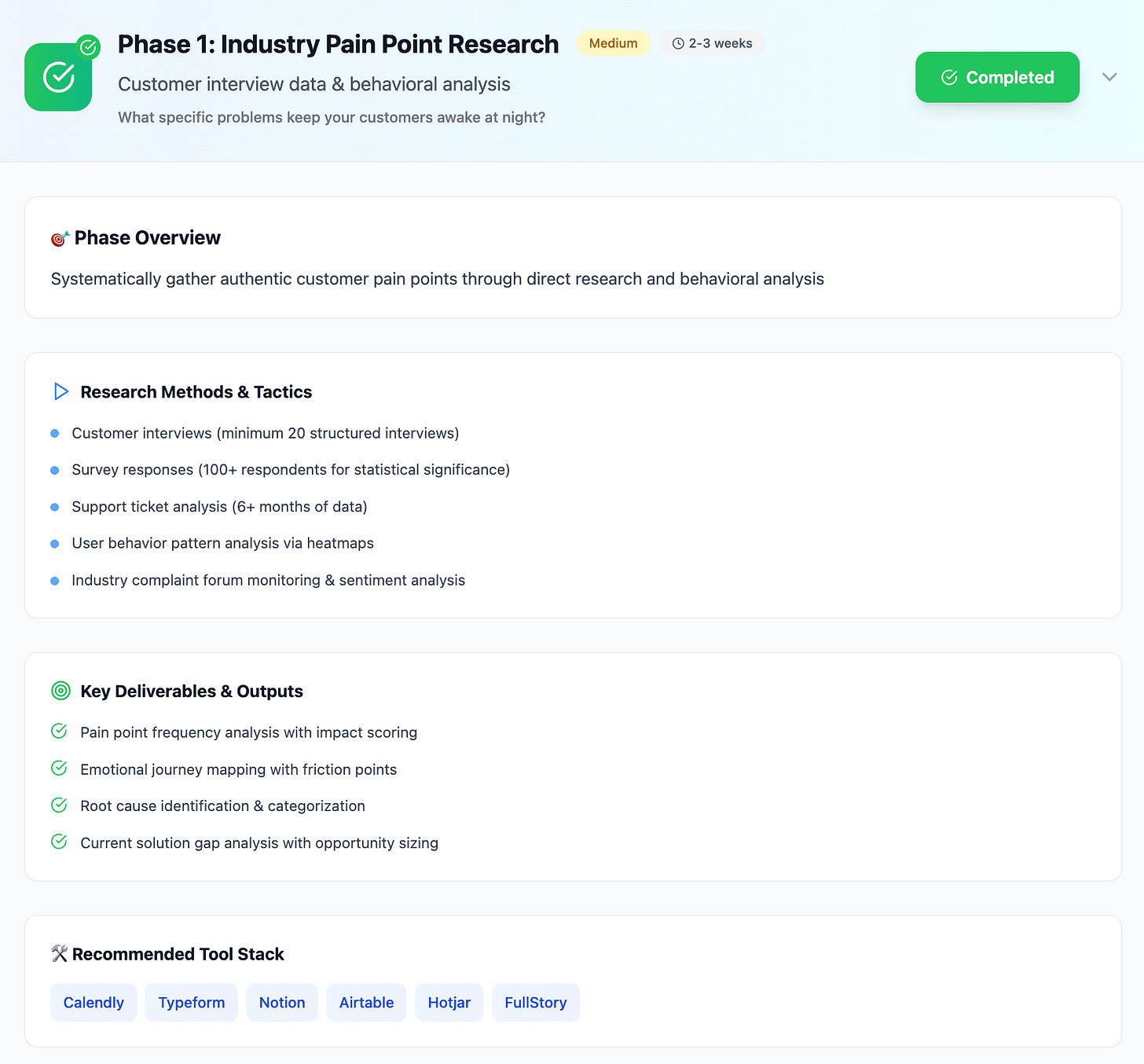

This was a very engaging article! I do have a couple of questions -
Is a contrarian POV important, or just having a POV important? Example - A POV that also informs your product strategy. I feel it's the latter. The unique POV that differentiates the solution in the market.
Also, if you recommend the contrarian POV approach, how often do you recommend changing/adding new POVs?